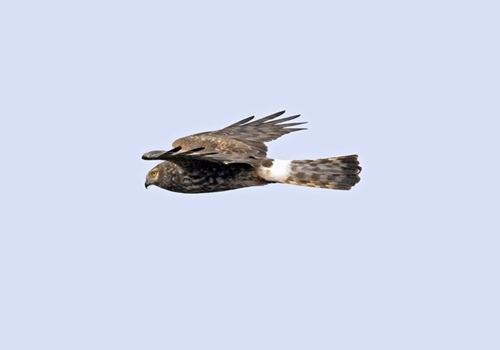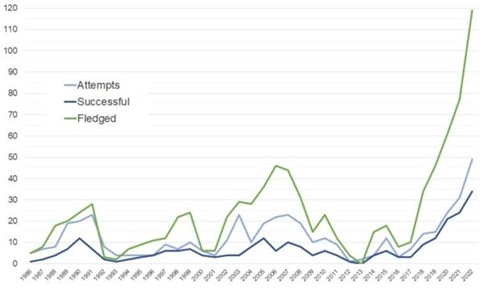Written by Nicholas Aebischer (Deputy Director of Research) and Henrietta Appleton, GWCT Policy Officer (England)

The debate over the conservation of hen harriers is one of the most controversial and polarised and as a consequence has been widely used in social science analyses of conservation conflicts. The level of polarisation has arguably increased since the release of the Hen Harrier Action Plan with its associated brood management and diversionary feeding solutions (1).
The 2023 announcement by Natural England (NE) of the renewal of the licence for brood management will hopefully contribute to resolving the conflict in England, but a recent publication reminds us of the extent of the problem, finding that up to three-quarters of annual hen harrier mortality is likely attributable to illegal killing associated with grouse moor management (2).
The GWCT's 'middle-ground' role in the debate
Given the GWCT’s recognised ‘middle-ground’ role (3) we have considered the findings of this paper from the perspective of its methodology and conclusions. As members and readers will know, the GWCT is completely opposed to the illegal killing of hen harriers (indeed any protected species). But equally we are concerned that views in this debate have become institutionalised (4) so it is important that balance is provided to facilitate dialogue and decision making.
In the words of Hodgson et al (2019) “Although the intention of such knowledge [research] use is unclear, the selective reconstruction of research by actors could stem from, and reiterate, divergent value systems.” (5) It is important in this debate that research methodologies and analyses are robust.
The need to distinguish between before and after brood management
Whilst the methodology is sound, our main concern is that the paper does not attempt to distinguish between the situation before and after hen harrier brood management in England started being implemented on the ground in 2019. The paper tells us that 148 hen harriers were tagged between 2014 and 2020, of which 25% were tagged in England. There is, however, no breakdown showing the numbers of harriers, year by year, tagged in Scotland and in England, nor showing the numbers recovered annually in the two countries.
It is therefore not plain how much the results reflect the situation before or after brood management in England. According to the Hen Harrier LIFE Project final report (5), 117 birds were tagged between 2015 and 2019, of which 31 were tagged in 2019. Assuming that these 117 are included in the 148 of the paper, that the balance were tagged in 2020, and that the proportions tagged annually were similar inside and outside England, the percentage of birds tagged in England after brood management is probably around 10%. The results are therefore dominated by the 90% or so of birds tagged either outside England or in England before brood management began. This implies that it would be unwise to take the findings as being representative of the current situation post brood management in England.

Indeed, the results of the brood management scheme in England to date have been considered sufficiently encouraging by NE to justify the renewal of the trial for a further two years. Over the last five years there have been signs of changing attitudes, good survival rates of the brood-managed individuals, a rise in annual number of hen harriers breeding in England with 34 successful nesting attempts in 2022 (from 9 in 2018) and an increase in their breeding success with 119 chicks fledged in 2022 (from 34 in 2018), including on land managed for grouse shooting (see graph)(7)
The future of brood management
The brood-managed individuals have also been satellite-tagged, but as the data are collected by NE, they have not contributed to the analysis discussed here. We understand that NE intends to report on its own findings once sufficient data have accumulated. We therefore expect that the next two years of the project will help produce the robust scientific evidence needed to understand the mechanisms by which brood management influences hen harrier population size and behaviour, and wider social science considerations such as changing human attitudes.
These results combined with the fact that the GWCT advocated the introduction of brood management to aid conflict resolution as long ago as 2002 justify, in our view, the adoption of a similar approach in Scotland and Wales, given that there is no conflict resolution measure in either nation at the moment. However, this does not obviate the industry’s obligation to eliminate unlawful behaviour.
The need for a lasting solution to the conflict
Regardless of how applicable the findings of this new paper are to the current situation in England, its findings emphasize an unacceptable side to upland game management that has no place in a modern world. The GWCT condemns the illegal killing of raptors or other wildlife in the strongest terms. By raising the profile of the issue, this paper highlights yet again the need for a lasting solution to a needlessly enduring conflict. The GWCT will seek to ensure that such a solution is evidence-based, as it has done already for over 30 years through its upland research and policy programme.
- Marino, F., Crowley, S. L., Williams Foley, N. A., McDonald, R. A., & Hodgson, D. J. (2023). Stakeholder discourse coalitions and polarisation in the hen harrier conservation debate in news media. People and Nature, 5, 668–683
- Steven R. Ewing et al., Biological Conservation, https://doi.org/10.1016/j.biocon.2023.110
- Marino et al (2023) (as above) and Hodgson, I. D., Redpath, S. M., Fischer, A., & Young, J. C. (2018). Fighting talk: Organisational discourses of the conflict over raptors and grouse moor management in Scotland.
- Ibid and Hajer (1993). Discourse coalitions and the institutionalization of practice: The case of acid rain in Britain. In F. Fischer & J. Forester (Eds.), The argumentative turn in policy analysis and planning (pp. 43–76). Duke University Press.
- Hodgson, I et al (2019) Who knows best? Understanding the use of research-based knowledge in conservation conflicts. Journal of Environmental Management 231 (2019) 1065–1075.
- RSPB (2020). Hen Harrier LIFE Project: Final Report Covering the Project Activities from 01/07/2014 to 21/12/2019. LIFE Project No. LIFE13 NAT/UK/000258, LIFE Programme, European Commission, Brussels.
- https://naturalengland.blog.gov.uk/2023/03/16/update-on-the-hen-harrier-brood-management-trial/#comments